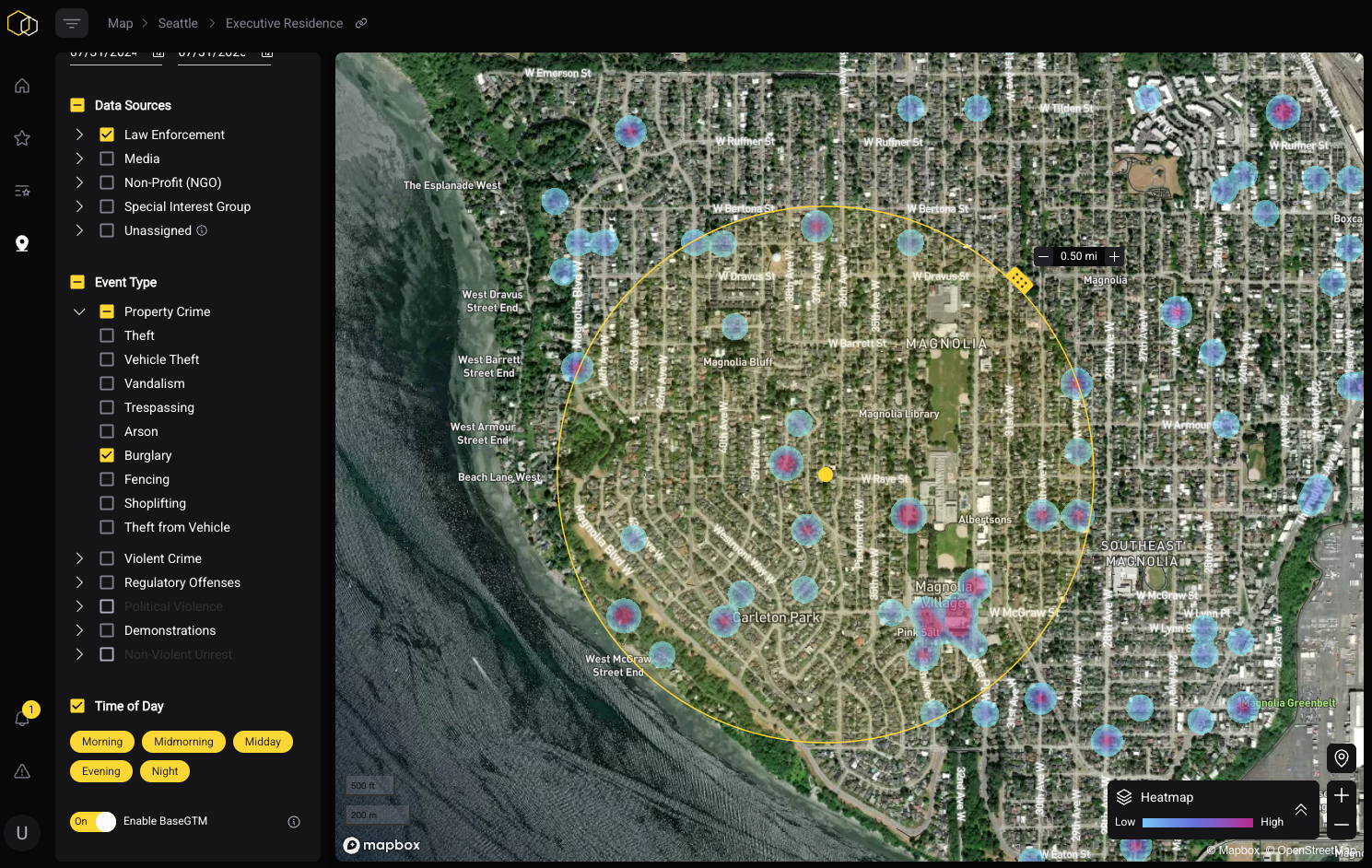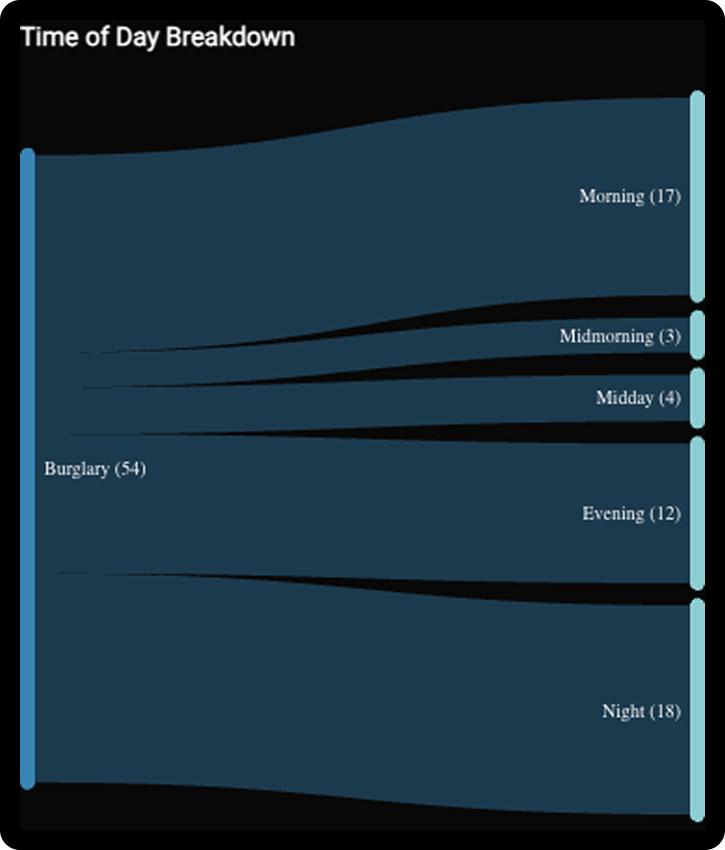
How a Fortune 500 Security Team Prevents Executive Residence Vulnerability
US-based Risk Intelligence team leveraged Base Operations to provide rapid, localized crime insights during the security design for a CEO residence. This helped ensure the system addressed real, location-specific risks from the start.

Zero security redesigns
100% security validation
90% faster threat assessment
Challenge
Rising incidents of high-net-worth residential burglaries in the Seattle area created immediate concern for executive safety. The Risk Intelligence team was tasked with supporting security design for a new CEO residence and needed current, hyperlocal threat context. Traditional integrator-led system designs often lack granular, up-to-date intelligence, which can leave blind spots.
Solution
The team implemented Base Operations to conduct rapid, localized threat assessments around executive residences. Within 30 minutes, they identified crime clusters within a 0.5-mile radius and shared actionable intelligence with security integrators. This data-driven approach gave them the evidence needed to get approval for additional security measures.
Results
- Prevented critical vulnerabilities through timely crime data insights
- Reduced assessment time from 5 hours to 30 minutes per location
- Established new precedent for data-driven residential security design
Background: When Traditional Security Design Falls Short
This Fortune 500 Travel Company's US-based Risk Intelligence team carries responsibility for protecting employees and executives across corporate and residential environments worldwide. Managing Employee Travel, Executive Protection, and Global Risk Advisory, the team faced an evolving threat landscape that traditional security approaches couldn't adequately address.
During the security design phase for a new CEO residence in Seattle, a nearby residential break-in underscored the value of incorporating localized threat intelligence into planning. The incident provided a clear example of how, without current and hyperlocal data, even high-cost system designs can overlook specific risks—particularly during the critical period before a property is occupied.
The Solution: Fast, Data-Driven Threat Assessments
Upon learning of the nearby break-in, the Risk Intelligence team immediately turned to Base Operations for a comprehensive threat assessment. The platform's 0.5-mile radius analysis capability revealed what manual research would have missed: a cluster of residential burglaries within a half-mile of the CEO's new residence.

Within 30 minutes (compared to the typical five hours required for manual compilation) the team had actionable intelligence. They captured detailed incident data including:
- Specific burglary patterns and times
- Historical crime trends in the immediate area
- Heatmaps of the local crime distribution
- Monthly trends and forecasts
This intelligence was passed off to the security integrators and directly informed critical security adjustments:
- Glass break sensors on upper floors (previously overlooked in original design)
- Enhanced perimeter gate access control with additional authentication layers

Measurable Impact on Executive Protection
Using Base Operations didn’t just help prevent critical security vulnerabilities around the CEO’s home, it delivered quantifiable results to their threat assessment operations.
Operational Efficiency:
- Assessment time reduced from approximately 5 hours to 30 minutes
- Labor cost per assessment: $65.10 (vs. $325.52 manual process)
- Eliminated need for $550 outsourced custom reports
Strategic Value:
- Zero post-installation security redesigns required
- 100% of security measures validated by threat data
- Proactive vulnerability identification before occupancy
The Risk Intelligence team’s proactive use of localized crime data reinforced their role as trusted partners in residential security planning. By delivering timely, relevant insights, they were able to support the security design process with confidence and credibility. This ensured executive leadership had the information needed to make informed decisions.
Looking Forward: Applying Data-Driven Insights to Executive Protection
This success shows how localized crime data was integrated into this Fortune 500 travel company's established executive protection practices. The Risk Intelligence team continues to apply similar data-driven assessments in scenarios such as:
- Global executive relocations: Pre-move threat assessments for international assignments
- Event security planning: Detailed site threat assessments for corporate gatherings
- Employee travel safety: Proactive alerts for business travelers entering higher-risk areas
- Vendor security validation: Verifying third-party security recommendations with independent data
By incorporating Base Operations into these workflows, the team can validate assumptions, refine security measures, and provide decision-makers with timely, relevant intelligence. Ultimately this helps to ensure that protective strategies remain well-informed and effective.
Key Takeaways for Security Leaders
- Proactive beats reactive: Identifying threats before security installation prevents costly redesigns and vulnerabilities
- Data drives credibility: Concrete threat intelligence elevates security teams from service providers to strategic advisors
- Speed enables action: 30 minute assessments allow you to deliver intelligence to more stakeholders and take immediate action
- Cost efficiency scales: 88% savings per assessment creates budget for additional security enhancements
- Integration multiplies value: Sharing threat data with partners improves entire security ecosystem
The Blind Spots You Don't Know You Have
Traditional executive protection operates on dangerous assumptions:
- Generic "high-net-worth" security packages
- 60-90 day old police reports
- City-level crime statistics applied to specific addresses
- Integrator recommendations without localized data
The Reality Check:
In Seattle's affluent neighborhoods, crime patterns vary dramatically within single zip codes. Standard security designs miss these granular realities.
Consider your current executive protection:
- Do you know what happened within 1000 yards of each residence last week?
- Can you identify crime patterns specific to 2-block radius zones?
- Would you know if criminals are testing nearby homes?
If you answered no to any of these, you're likely operating blind.
The Question Every CSO Must Answer
Your executives' homes are either protected by data or exposed by assumptions.
Which is it?
While competitors rely on fragmented police reports and generic security packages, forward-thinking security leaders are preventing incidents before they occur. They're adjusting security measures based on actual patterns, not theoretical risks.
The break-ins near the Fortune 500 travel company's CEO residence could have been a wake-up call arriving too late. It could have come after a family was put at risk, after headlines damaged reputation, and after trust was broken.
Instead, it showed how proactive intelligence prevents what reactive security can only respond to.
Related Case Studies

Leading AI Provider Reduces Executive Protection Assessment Time by 75% and Increases Threat Coverage 3x
Fast-growing AI company builds a data-driven executive protection program using street-level threat intelligence and AI-enhanced analysis to protect rapidly expanding C-suite across global operations.






